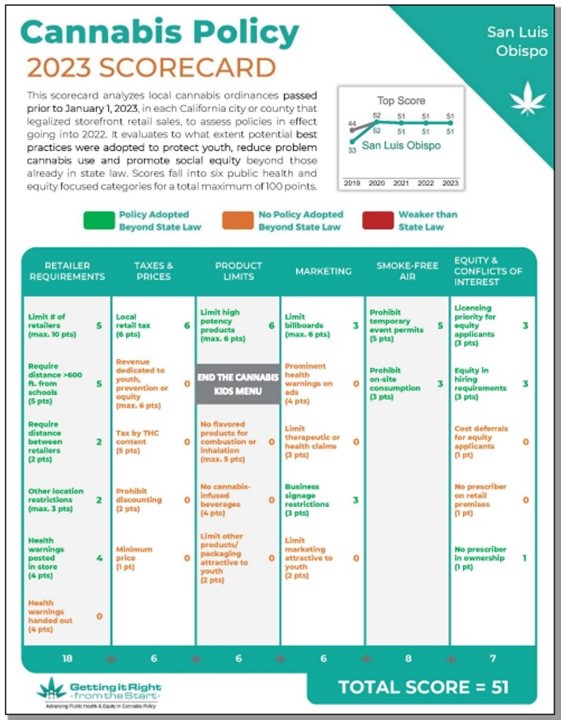
Press Release
State of Cannabis Report: Are Local Policies Protecting Us?
-
Focus Areas
Healthy Communities -
Issues
Cannabis -
Expertise
Public Policy Advocacy, Research – Survey -
Programs
Getting it Right from the Start: Advancing Public Health & Equity in Cannabis Regulation, Prevention Policy Group

Scorecards reveal pathway forward for cities, counties to better protect youth & public health
(Oakland, CA) Today, Getting it Right from the Start, a project of the Public Health Institute (PHI), released its 5th annual State of Cannabis Report, tracking adoption of key policies by cities and counties that allow cannabis retail sales. The 2023 scorecards bring to light a patchwork of local policies that continue to fall far short of what is necessary to prevent the cannabis industry from following in the footsteps of Big Tobacco. Despite examples of localities that have led the way, many have not yet opted to go beyond basic state law to promote public health, protect youth, or advance social equity.

Governor Newsom’s October 8th veto of the Cannabis Candy Child Safety Act (AB1207-Irwin) made it evident that it is up to local governments to protect kids from these cannabis risks. And the need is urgent. These scorecards offer practical information for communities on how to provide legal access without driving up harmful consumption, keeping our kids safer.Lynn Silver, MD, MPH, FAAP
Program Director, Getting it Right from the Start, Public Health Institute

Cannabis Policy 2023 Scorecards
California cities and counties can now measure how well their cannabis ordinances are protecting youth and supporting social equity in the first five years of legalization. Scorecards summarize the evolution of cannabis policies in the 298 California cities and counties that have opted to permit retail sales, whether through storefronts and/or by delivery, of cannabis. The scorecards bring light to a patchwork of local policies that continue to mostly fall far short of what public health leaders believe is necessary.
The scorecard is based on a 100-point scale, with the higher score representing the more robust public health protections enacted over the last five years, and measured across six categories: retailer requirements, taxes and prices, product limits, marketing, smoke-free air, and equity and conflicts of interest.
The City of San Luis Obispo (SLO) scored the highest of all jurisdictions, with 51 points, thanks to several early and bold actions such as limiting the number of retailers and distancing them from places that serve youth. Contra Costa County was second (50 points), showing national leadership by prohibiting the sale of flavored products for inhalation, widely known to hook kids. The statewide average score however, remained a paltry 22 of 100 possible points across all jurisdictions allowing storefront retailers, and 12 for those allowing sale only by delivery, illustrating the enormous space for local action.
National City was the most improved jurisdiction that allows storefronts, rising 12 points to 28, by passing a local tax, prioritizing equity applicants, and requiring equitable hiring. The City of Los Angeles was second, with an improvement of 9 points to 39, by requiring in-store warnings and prohibiting temporary events, informing consumers, and maintaining our commitment to smoke-free air protections.
In 2021 alone, California had 791 cannabis exposure calls to poison control centers for children five or younger – an increase of 140% since 2018. The number of US 12th graders who have used highly potent cannabis vapes in the preceding month tripled in five years to 14% (16.2% in CA), which can have lasting negative impacts on the developing adolescent brain. California experienced a near doubling of use during pregnancy over the past decade, and a 75% increase in cannabis-related emergency department visits in just four years.
Yet, the state and most jurisdictions remain remiss in addressing these growing public health challenges. Only 10 of the 539 California localities enacted any cannabis product restrictions. A handful of innovative pioneers, however, illustrate the kinds of robust local action possible. SLO prioritizes retail applicants that offer low-THC products and Grass Valley and Cathedral City tax high-potency products more heavily. Recognizing the role of flavors and kid friendly marketing in initiating youth use, Contra Costa County, Watsonville, and Chico prohibit flavored inhaled products. Three jurisdictions ban cannabis-infused beverages (like orange soda). Monterey County authorizes its Health Officer to review products annually to ensure that packages are not attractive to children.
“The County of Santa Clara Public Health Department supports and enacts efforts to prevent cannabis products from ending up in the hands of youth. Substance use is a public health problem, and these scorecards provide clear metrics that can guide policy decisions and set up guardrails for healthier communities,” said Rhonda McClinton-Brown, County of Santa Clara Public Health Department Deputy Director for Strategy, Policy, and Planning.
Despite industry claims to the contrary, 2023 data show that 63% of Californians live where they can legally buy cannabis (up from 56% in 2019). Many more are within an easy trip to retailers in neighboring jurisdictions. Only 3 of 58 counties had no location allowing legal sale, 36% of jurisdictions allow storefronts, and an additional 19% allow sales only by delivery, including 68 which don’t issue local licenses but permit delivery from outside their jurisdiction.
Other report highlights include:
- 77% (a 6% increase from 2019) of jurisdictions allowing storefront retailers limited the number of outlets.
- 74% of jurisdictions allowing storefronts established stronger buffers than the state to distance storefront outlets from schools and youth.
- 175 (9% increase from 2019) jurisdictions enacted local cannabis taxes, which remained low and stable at only 5%, yet only 21 spent these revenues on substance abuse prevention, youth programs, or mitigating the impact of the war on drugs.
- Most jurisdictions kept storefront retailers smoke-free and a growing number (72) prohibited temporary cannabis events such as those in parks or markets, though 49 (up from 35 in 2019) went backward on smoke-free air by allowing on-site cannabis consumption, bringing back the era of “smoke-filled rooms.”
- Only 36 jurisdictions had specific policies for equity in hiring or licensing, but this is up from six in 2019, demonstrating the limited priority given to economic equity.
The scorecards, the research methodology and many other resources are available at www.gettingitrightfromthestart.org.
Important note: These scorecards reflect how local laws protect youth, public health, and equity. They do not capture how local governments are implementing their laws, inspecting cannabis businesses, or funding prevention and implementation, which we recognize many local governments’ staff work hard to do, and do well.
Getting it Right from the Start, a project of the Public Health Institute, works with states, cities, counties and community partners to develop evidence-based model policies and provide guidance on cannabis policies that can help reduce harms, protect against youth and problem cannabis use, and advance social equity.
Public Health Institute improves health, equity, and wellness by discovering new research, strengthening key partnerships and programs, and advancing sound public health policies. Their hundreds of programs have impacted millions of people, creating a framework that will continue to impact communities for generations to come.
More Updates
Work With Us
You change the world. We do the rest. Explore fiscal sponsorship at PHI.
Support Us
Together, we can accelerate our response to public health’s most critical issues.
Find Employment
Begin your career at the Public Health Institute.



